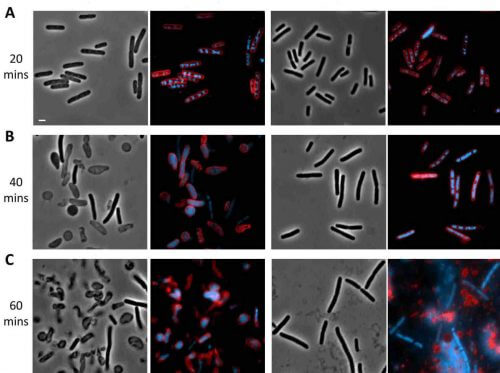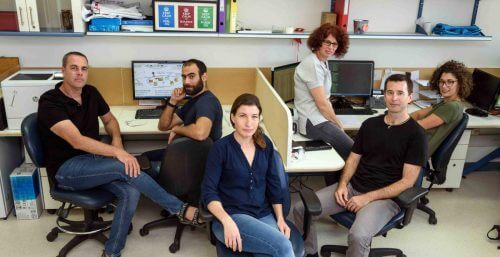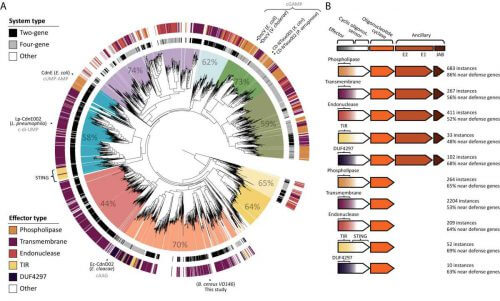An immune mechanism in bacteria is the ancestor of an antiviral immune pathway in our cells

More than a billion years of evolution have passed since our ancestors split from the primordial bacteria, yet our immune systems share with these single-celled creatures an important defense mechanism. This fact was discovered in a study by Weizmann Institute of Science scientists that was recently published in the scientific journal Nature. The research findings shed light on the evolution of the immune responses in our body, and may lead to new insights in the treatment of autoimmune diseases.
Bacteria have to constantly defend themselves against viruses that attack them, called phages. The most famous immune mechanism of bacteria, CRISPR, which neutralizes phages by editing their DNA, is currently used in biological laboratories for gene editing. However, there are dozens of additional defense mechanisms - many of which were discovered in the laboratory of Prof. Rotem Sorek from the department of molecular genetics at the institute. In the current study Prof. Sorek and his research team focused on a molecule that was discovered in bacteria only in recent years and is known as cGAMP. They knew that this molecule, which consists of the two nucleotides A and G, is part of an immune mechanism that exists in every cell of our body: when a human cell detects the presence of viral DNA, it produces cGAMP which leads to the activation of the interferon molecule, which in turn calls the immune system for help the infected cell.
The origin of the autonomous immune mechanisms in our cells is at a time when all creatures were single-celled and without a nucleus. In other words, the first eukaryote - the organism in which a cell nucleus first appeared - was already equipped with this anti-viral mechanism, which developed into the immune mechanism we know today in humans"

However, unlike the cells of our body, bacteria function as independent units and cannot recruit cells of the immune system to help them. What, then, do they need cGAMP for? The researchers hypothesized that this molecule also has a protective role in bacteria, and they found confirmation of this when they located the genes responsible for cGAMP production in "defense islands" - areas in the bacterial genome where genes related to immune activity tend to cluster together. In order to check if these genes are indeed related to immune activity, the researchers transferred them from bacteria in which they occur naturally, to bacteria without this system (E.coli) and infected the engineered bacteria with phages. They found that the colonies of the engineered bacteria grew well in their laboratory plates and exhibited resistance to a wide variety of phages.
"We discovered that, similar to this immune mechanism in humans, the bacterial mechanism senses the invasion of the virus, and then activates the production of cGAMP", says Prof. Sorek. This mechanism protects the bacteria by causing them to commit suicide before the phages can replicate themselves and endanger the rest of the colony. Such altruistic suicide was once thought to be the exclusive property of multicellular organisms, but today it is known to occur in many unicellular organisms as well.
While Prof. Sorek and his team were studying this ancient immune mechanism, another research group, at Harvard University, discovered that bacteria can produce a variety of molecules similar to cGAMP. All these molecules consist of combinations of nucleotides linked together in a circular configuration. Prof. Sorek's research group found that these molecules are also part of antiphage systems that work in a similar way to cGAMP.

"All these circular nucleotide systems are apparently immune defense systems. It seems that the differences between them lie in the preferred method of suicide: the cGAMP system pierces the cell membrane, while another cleaves the DNA of the bacterium and so on," says Prof. Sorek and adds: "The origin of the autonomous immune mechanisms in our cells is at a time when every The creatures were single-celled and without a nucleus. In other words, the first eukaryote - the organism in which a cell nucleus first appeared - was already equipped with this anti-viral mechanism, which developed into the immune mechanism we know today in humans."
These findings may also be relevant to human health. The human version of this immune mechanism is involved in autoimmune diseases. "We know that certain phages manage to evade this immune mechanism. If we manage to learn from them how to disable the immune response, we may be able to use this insight to treat diseases in which the immune system attacks the body itself instead of external invaders," says Prof. Sorek.
#Science numbers: Scientists estimate that the number of phages in the world is 10 billion times the number of stars in the universe. If we were to weigh all these phages together, their weight would be greater than the weight of all humanity.
